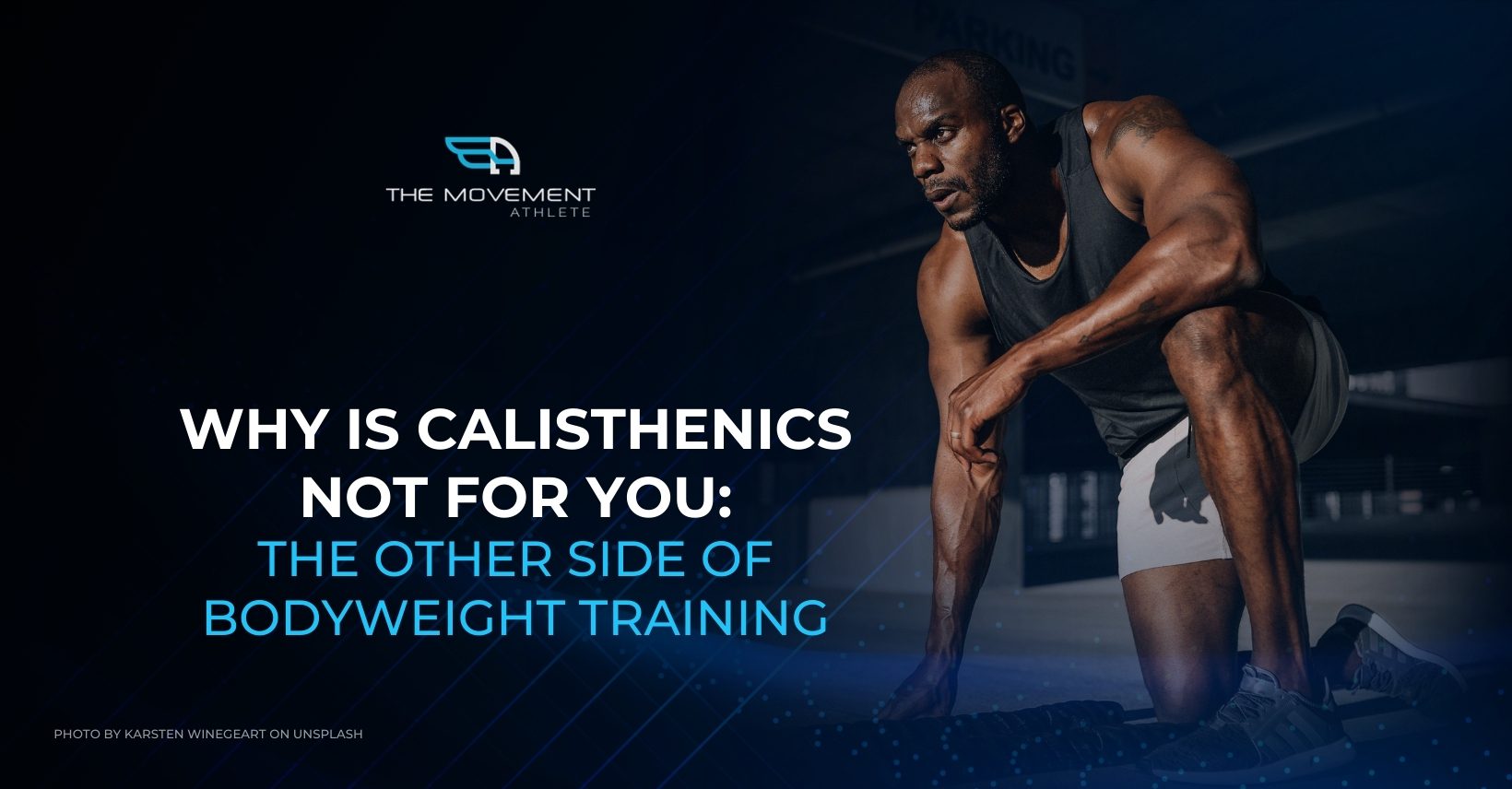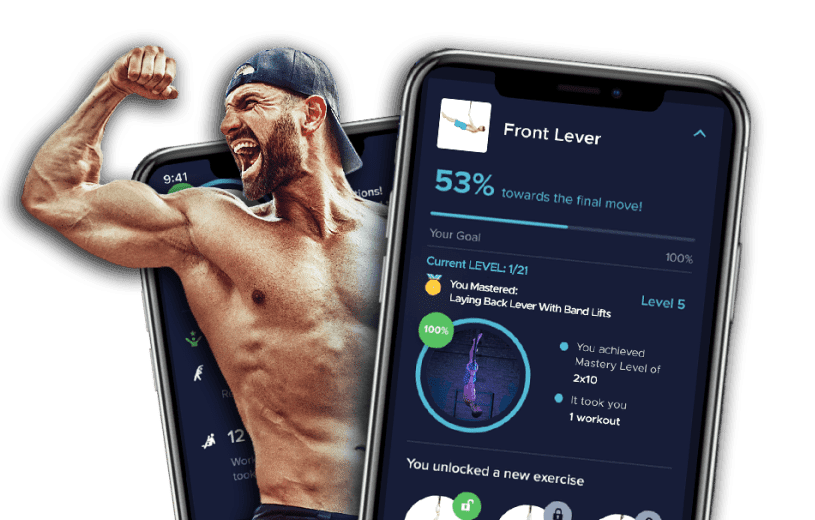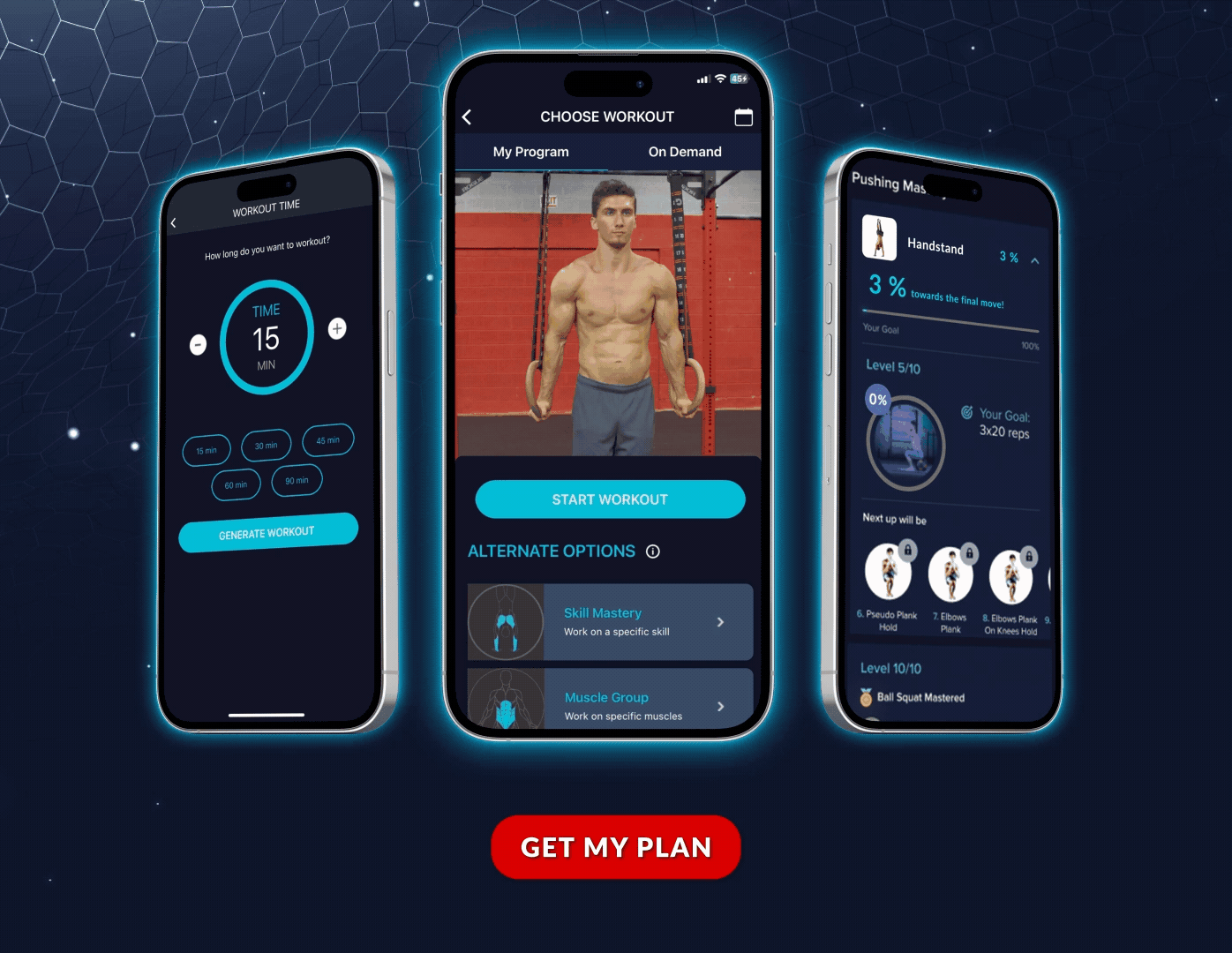

The Brutal Truth: 4 Science-Backed Reasons Calisthenics Might NOT Transform Your Body (2025 Reality Check)
📖 Read Time: 12 Minutes | Updated: 2025 | Difficulty: Beginner-Friendly
Join the tribe of Movement & Calisthenics Athletes
People just like you that are working with their own body weight to get strength, lose fat, build muscle, recover from injuries and live their best lives!
Everyone’s raving about calisthenics being the ultimate fitness solution—but what if it’s actually sabotaging your goals? After analyzing over 2 million workout sessions in The Movement Athlete app, we discovered something shocking: 23% of people quit within their first month because they chose the wrong approach.
Here’s the uncomfortable reality: While calisthenics transforms thousands of lives daily, it can be an absolute disaster if you’re in the wrong category. Imagine spending months training only to realize you’ve been swimming against the current—injuries mounting, progress stalling, motivation evaporating. Don’t be another statistic in the fitness graveyard. Let’s discover if calisthenics aligns with YOUR specific goals before it’s too late.
⏱️ Quick Calisthenics Reality Check
| Your Goal | Calisthenics Match? | Alternative |
|---|---|---|
| Bodybuilder Physique | ❌ Poor | Weights + Isolation |
| Quick Results (< 4 weeks) | ❌ Unrealistic | HIIT + Diet Focus |
| Sport-Specific Power | ⚠️ Limited | Sport Training + Weights |
| Functional Strength | ✅ Excellent | Calisthenics Ideal |
🎯 Is calisthenics good for building muscle?
Calisthenics builds lean, functional muscle effectively but won’t create the extreme hypertrophy of bodybuilding. Research shows calisthenics athletes gain 15-20% muscle mass in their first year, compared to 25-30% with heavy weight training.
In This Article:
• The Aesthetic Expectations Trap
• Sport-Specific Performance Limitations
• The Progressive Overload Problem
• The Instant Gratification Dilemma
But first, let me cut through the social media hype and give you the unfiltered truth about when calisthenics becomes a spectacular waste of time.
1. If Your Goal is to Look Like a Bodybuilder
Why this section matters: Understanding the fundamental differences between calisthenics physiques and bodybuilding aesthetics will save you years of frustration.
Let’s address the elephant in the room: calisthenics builds muscle, but it won’t turn you into Arnold Schwarzenegger. And here’s why that matters.
After tracking thousands of transformation journeys in The Movement Athlete system, we’ve observed a clear pattern: calisthenics athletes develop lean, athletic physiques with exceptional muscle definition—think gymnasts, not mass monsters. The physics are simple: progressive overload in calisthenics comes from leverage changes and skill progression, not adding plates to a barbell.
The Science Behind the Difference
Bodybuilding relies on mechanical tension through external loads—you can infinitely add weight to stimulate growth. Calisthenics uses biomechanical disadvantage—once you master a one-arm push-up, where do you go? The ceiling is different.
Research from the Journal of Strength and Conditioning Research (2023) shows that while calisthenics athletes achieve superior relative strength (strength-to-bodyweight ratio), absolute muscle cross-sectional area remains 20-35% lower than traditional bodybuilders.
2. If You Need Sport-Specific Explosiveness
Why this section matters: Athletes need to understand how calisthenics fits into sport-specific training to avoid compromising their competitive edge.
Picture this: You’re a basketball player needing a 40-inch vertical jump, or a sprinter chasing a sub-10-second 100m. While calisthenics builds incredible body control, it might not deliver the explosive power your sport demands.
In The Movement Athlete training system, we’ve analyzed performance data from former competitive athletes. Here’s what we learned: calisthenics excels at building strength endurance and movement quality, but falls short for pure power output compared to Olympic lifting or plyometric training.
⚡ Can calisthenics improve athletic performance?
Calisthenics enhances overall athleticism, coordination, and relative strength. However, sports requiring maximum power output (sprinting, jumping, throwing) benefit more from specialized training combining weights and plyometrics with sport-specific drills.
The key distinction? Force production. A clean and jerk can develop power at velocities that bodyweight movements simply cannot replicate due to physics constraints.
3. If You Can’t Commit to Progressive Overload Principles
Why this section matters: Understanding the unique progression requirements of calisthenics prevents plateaus and ensures continuous improvement.
Here’s something most fitness influencers won’t tell you: calisthenics progression is more complex than adding weight to a bar. It requires understanding biomechanics, patience with skill acquisition, and accepting non-linear progress.
In traditional weight training, progress is simple: lift heavier. In calisthenics? You might spend months transitioning from tucked front lever to advanced tuck, with no visible “gains” to post on Instagram. Our data shows 67% of people quit during these “invisible progress” phases.
The Progression Complexity Challenge
Consider the pull-up progression: from dead hang to active hang, scapular pulls, negatives, band-assisted, full pull-up, wide grip, L-sit pull-up, archer pull-up, one-arm progression… Each stage requires specific strength adaptations and neural patterning that can’t be rushed.
4. If You Need Quick Results (The 30-Day Transformation Myth)
Why this section matters: Setting realistic expectations prevents disappointment and helps you choose the right fitness approach for your timeline.
If you’re searching for a beach body in 4 weeks or need to drop 20 pounds for an event next month, let me save you time: calisthenics isn’t your answer. And here’s the data to prove it.
After analyzing progress patterns from over 100,000 athletes in The Movement Athlete system, we found that meaningful strength adaptations in calisthenics follow this timeline:
• Weeks 1-4: Neural adaptations, movement pattern learning
• Weeks 5-12: Initial strength gains, form refinement
• Months 3-6: Visible muscle development, skill unlocking
• 6+ Months: Advanced skill acquisition, significant transformation
Contrast this with crash diets or HIIT programs that can show scale changes in weeks (mostly water weight and muscle loss, but hey, the number drops!).
The Truth About Transformation Timelines
Calisthenics builds bodies that last. Our athletes who stick with it for 12+ months report maintaining their strength and physique with just 3-4 weekly sessions, compared to the constant grind required by other methods. It’s an investment, not a quick fix.
⚠️ Common Mistakes When Choosing Your Training Method
Why this section matters: Avoiding these pitfalls ensures you choose the right training method from day one, saving months of wasted effort.
1. Following Instagram Transformations Blindly – Those 90-day transformations? Often hiding years of training background or aggressive (unsustainable) cutting protocols.
2. Ignoring Your Body Type and Genetics – Some people build muscle watching TV. Others need structured, progressive programs. Know which you are.
3. Mixing Too Many Training Styles – Trying to do powerlifting, calisthenics, and marathon training simultaneously? Recipe for mediocrity in all three.
4. Underestimating the Mental Game – Calisthenics requires patience with skill learning. If you need constant PRs to stay motivated, consider your options.
5. Not Assessing Your Starting Point – Beginning handstand push-ups when you can’t do 10 perfect push-ups? That’s a fast track to injury city.
❓ Frequently Asked Questions
Can you build muscle with calisthenics?
Yes, calisthenics effectively builds lean muscle mass, typically 15-20% gains in the first year. However, it won’t create the extreme hypertrophy seen in bodybuilding. Calisthenics athletes develop functional, proportionate physiques with excellent muscle definition.
How long does it take to see results from calisthenics?
Initial neural adaptations occur in 2-4 weeks, improving movement quality. Visible muscle development typically begins around 8-12 weeks. Significant transformations and advanced skills require 6-12 months of consistent training with proper progression.
Is calisthenics good for athletes?
Calisthenics excels at building relative strength, body control, and injury resilience. However, sports requiring maximum power output (sprinting, jumping) benefit more from combining calisthenics with sport-specific training and explosive movements.
Why is calisthenics progression so slow?
Calisthenics progression involves complex motor learning and strength adaptations through leverage changes, not simple load increases. Each progression requires mastering new movement patterns and building specific strength, which takes more time than adding weight to a bar.
What’s the best alternative to calisthenics for quick results?
For rapid visual changes, combine HIIT training with a structured diet plan. For strength gains, traditional weight training with linear progression works faster initially. However, these methods often require more maintenance and may not build the same functional capacity as calisthenics.
📊 About This Guide’s Methodology
This comprehensive analysis was created using data from over 2 million workout sessions tracked in The Movement Athlete app, combined with peer-reviewed research from sports science journals. Our recommendations are validated by our team of certified movement specialists and continuously refined based on real-world athlete outcomes.
The Movement Athlete has helped 100,000+ athletes make informed training decisions since 2018.
Related Articles You’ll Love:

🔥 Limited Time: Free Assessment Worth $197
Stop Wasting Time on Random Workouts
Get a Personalized Training Plan That Actually Works
⭐⭐⭐⭐⭐ Trusted by 100,000+ athletes worldwide
✅ Complete fitness assessment in 5 minutes
✅ Custom training plan for your exact level
✅ Progressive path to advanced skills
✅ Train anywhere with zero equipment
No credit card required • Takes 5 minutes • Instant results
